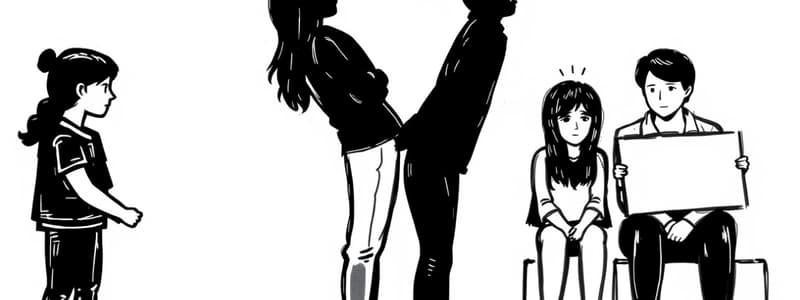Podcast
Questions and Answers
What behaviors constitute harassment based on federal civil rights law?
What behaviors constitute harassment based on federal civil rights law?
- Unwelcome behaviors based on a person's identity (correct)
- Childish teasing that is not taken seriously
- Friendly banter between individuals
- Severe and persistent actions that create a humorous atmosphere
Which of the following is NOT a common location where bullying occurs?
Which of the following is NOT a common location where bullying occurs?
- The Internet
- Playgrounds
- Personal homes (correct)
- School buildings
What is considered sexual harassment?
What is considered sexual harassment?
- Uninvited sexual conduct or remarks (correct)
- Playing harmless pranks on a friend
- Complimenting someone at work
- Sharing jokes about a person's background
Which statement about unwanted touching is true?
Which statement about unwanted touching is true?
When does joking turn into harassment?
When does joking turn into harassment?
What type of crime becomes a hate crime?
What type of crime becomes a hate crime?
What differentiates bullying from harassment?
What differentiates bullying from harassment?
What can constitute unwanted touching?
What can constitute unwanted touching?
What is one common reason that bullies target teens?
What is one common reason that bullies target teens?
Which of the following best describes a characteristic of bullies?
Which of the following best describes a characteristic of bullies?
What is a possible legal implication of harassment based on differences?
What is a possible legal implication of harassment based on differences?
Where might bullying frequently occur among teens?
Where might bullying frequently occur among teens?
How should a victim of bullying ideally respond to harassment?
How should a victim of bullying ideally respond to harassment?
Which type of bullying involves physical actions such as hitting or kicking?
Which type of bullying involves physical actions such as hitting or kicking?
What is a common characteristic of verbal bullying?
What is a common characteristic of verbal bullying?
In which grades is bullying behavior often reported to be most prevalent?
In which grades is bullying behavior often reported to be most prevalent?
Which of the following is an example of psychological bullying?
Which of the following is an example of psychological bullying?
What percentage of students in grades 9 to 12 have experienced bullying, according to the 2015 Youth Risk Behavior Surveillance System?
What percentage of students in grades 9 to 12 have experienced bullying, according to the 2015 Youth Risk Behavior Surveillance System?
What might male bullies often use to intimidate their victims?
What might male bullies often use to intimidate their victims?
Where can bullying occur?
Where can bullying occur?
Which behavior is NOT categorized as physical bullying?
Which behavior is NOT categorized as physical bullying?
Which of the following best describes bullying?
Which of the following best describes bullying?
What emotional impact can bullying have on victims?
What emotional impact can bullying have on victims?
What type of conduct does the content identify as related to harassment?
What type of conduct does the content identify as related to harassment?
What is a recommended first step if someone is experiencing harassment?
What is a recommended first step if someone is experiencing harassment?
In which situation can harassment be reported according to the content?
In which situation can harassment be reported according to the content?
What is one reason highlighted for why teens might get bullied?
What is one reason highlighted for why teens might get bullied?
What action may be appropriate if the harassment does not cease after asserting a firm stance?
What action may be appropriate if the harassment does not cease after asserting a firm stance?
Which of the following behaviors is categorized as harassment?
Which of the following behaviors is categorized as harassment?
What is a common reaction for teens to want to do during their adolescent years, according to the content?
What is a common reaction for teens to want to do during their adolescent years, according to the content?
What is an example of gender discrimination mentioned in the content?
What is an example of gender discrimination mentioned in the content?
What should you do if a person continues to harass you despite telling them to stop?
What should you do if a person continues to harass you despite telling them to stop?
Which of the following is NOT a type of harassment mentioned?
Which of the following is NOT a type of harassment mentioned?
Study Notes
Bullying and Harassment Overview
- Bullying commonly occurs in school environments, including buildings, playgrounds, buses, and online.
- Harassment, defined by federal civil rights law, can arise from joking that hurts another person, especially related to race, gender, or religion.
- Hate crimes are violent acts committed against individuals or groups based on their racial, religious, or sexual backgrounds.
Types of Harassment
- Unwanted touching can signify power dynamics, where a person touches another without consent, such as forced hugs or inappropriate contact.
- Sexual harassment involves unwelcome sexual conduct, including inappropriate messages or gestures and is illegal.
- Gender discrimination occurs when individuals are judged based on their gender, affecting both males and females.
Responding to Harassment
- Ineffective responses to harassment include ignoring the behavior; assertiveness is crucial.
- Communicate directly to the harasser, stating the behavior is unacceptable and reporting if it persists.
- Seek support from parents or guardians to navigate the situation, as harassment is illegal.
Reasons Teens Experience Bullying
- Bullying often stems from the bully's need to feel superior or mask their insecurities.
- Teens who are different (in appearance, athletic ability, interests) may be more likely to be targeted.
- Social dynamics, such as fitting into groups, often influence bullying behavior.
Types of Bullying Behaviors
- Physical Bullying: Involves hitting, kicking, tripping, or taking belongings.
- Verbal Bullying: Includes taunting, teasing, and making threats.
- Psychological Bullying: Involves intimidation, spreading rumors, or public embarrassment.
Bullying Environments
- Bullying occurs almost anywhere during or after school hours, often targeting students considered different or vulnerable.
- Characteristics that make teens targets include low self-esteem, lack of social skills, or being perceived as weak.
Factors Leading to Bullying
- Teens bullying others may do so to fit in, assert power, or because of their low self-esteem.
- Many bullied teens act aggressively to avoid being bullied themselves, perpetuating a cycle of bullying unless addressed.
Federal Protections Against Harassment
- Federal laws protect individuals from harassment based on national origin, race, skin color, gender, age, and religious beliefs.
Studying That Suits You
Use AI to generate personalized quizzes and flashcards to suit your learning preferences.
Related Documents
Description
This quiz explores the critical topics of bullying, harassment, and gender discrimination in school settings. It covers definitions, examples, and the various forms of harassment, including sexual harassment and hate crimes. Test your knowledge on effective responses to these harmful behaviors.




